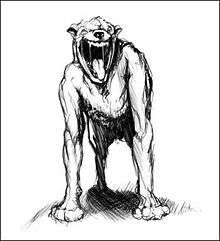Kalenjin people
| Total population | |
|---|---|
| 4,967,328[1] | |
| Regions with significant populations | |
| Languages | |
| Kalenjin | |
| Religion | |
| Christianity, African Traditional Religion | |
| Related ethnic groups | |
| Maasai, Samburu, Turkana, other Nilotic peoples |
The Kalenjin are a Nilotic ethnic group inhabiting much of what was the Rift Valley Province in Kenya. They are estimated to number a little over 4.9 million individuals as per the Kenyan 2009 census.[2] Kalenjin in Kenya are divided into the Kipsigis, Nandi, Keiyo, Marakwet, Sabaot, Pokots, Tugen, Terik and Ogiek/Dorobo. They speak the Kalenjin language, which belongs to the Nilo-Saharan family.
Prehistory
Origins
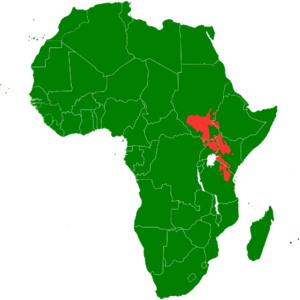
Linguistic evidence points to the eastern Middle Nile Basin south of the Abbai River, as the ancient homelands of the Kalenjin. That is to say south-east of present-day Khartoum. They were not a distinct group of people at this time but part of a wider society today referred to as Nilotic peoples.[3]
Beginning in the second millennium B.C., particular Nilotic communities began to move southward into present day South Sudan where most settled. However the societies today referred to as the Southern Nilotes pushed further on, reaching what is present day north-eastern Uganda by 1000 B.C.[3]
Early presence in Kenya
Ehret postulates that between 1000 and 700 BC, the Southern Nilotic speaking communities, who kept domestic stock and possibly cultivated sorghum and finger millet,[4] lived next to an Eastern Cushitic speaking community with whom they had significant cultural interaction. The general location of this point of cultural exchange being somewhere near the common border between Sudan, Uganda, Kenya and Ethiopia.
The impact of the cultural exchange was most notable in borrowed loan words, adoption of the practice of circumcision and the cyclical system of age-set organisation.[5]
The movement by the Southern Nilotic speakers into the Rift Valley to occupy what would become their traditional lands was a complex process and contemporary scholars present competing theories around them. The consensus among historians and linguists is that from about 500A.D, the linguistic ancestors of the Kalenjin moved eastward and southward from a base near Mt Elgon and into the Rift Valley[6]
Sirikwa Era
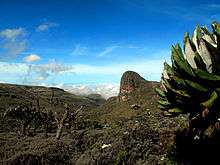
From about 700AD[7] the early traces of a culture today referred to as the Sirikwa societies appear in the archaeological record. Radiocarbon dating of archaeological excavations done in Rongai (Deloraine) have ranged in date from around 985 to 1300 A.D and have been associated with the early development phase of the Sirikwa culture. From here the culture radiated outwards toward the western highlands, the Mt. Elgon region and possibly into Uganda.[8]
Between 1200AD and 1300AD the Sirikwa societies proper emerge to become the dominant population of the western highlands of Kenya for the next six centuries.
At their greatest extent, their territories covered the highlands from the Chepalungu and Mau forests northwards as far as the Cherangany Hills and Mount Elgon. There was also a south-eastern projection, at least in the early period, into the elevated Rift grasslands of Nakuru which was taken over permanently by the Maasai, probably no later than the seventeenth century. Here Kalenjin place names seem to have been superseded in the main by Maasai names[9] notably Mount Suswa (Kalenjin – place of grass) which was in the process of acquiring its Maasai name, Ol-doinyo Nanyokie, the red mountain during the period of European exploration.[10]
Archaeological evidence indicates a highly sedentary way of life and a cultural commitment to a closed defensive system for both the community and their livestock during the Sirikwa era. Family homesteads featured small individual family stock pens, elaborate gate-works and sentry points and houses facing into the homestead; defensive methods primarily designed to proof against individual thieves or small groups of rustlers hoping to succeed by stealth.[11] A commitment to trade in this period is also highlighted by fact that the ancient caravan routes from the Swahili coast led to the territories of the Kalenjin ancestors.[12]
The Maasai Era
The Ateker-speakers, represented in the present-day by the Turkana, were the last of the indigenous ethnic groups to arrive in modern-day Kenya and their rise had far reaching effects on neighboring peoples, most notably the Maa and Kalenjin speakers. Impelled by demographic and ecological pressures sparked by the Aoyate (the long dry time) drought, they began encroaching on the territory of Sirikwa era Sengwer and Loikop thus setting of a period of widespread chaos and warfare[13].
As the Maasai were displaced from the homeland in the north of Kenya, they developed or borrowed an array of social and political changes that allowed them to expand swiftly, transforming them in a few generations from an obscure group to the regions dominant society.[14]
These cultural changes, particularly the innovation of heavier and deadlier spears amongst the Maasai led to significant changes in methods and scale of raiding bringing about the Maasai era of the late-18th and 19th centuries. The change in methods introduced by the Maasai however consisted of more than simply their possession of heavier, and more deadly spears. There were more fundamental differences of strategy, in fighting and defense and also in organization of settlements and of political life.[11]
In the Maasai era, guarding cattle on the plateaus depended less on elaborate defenses and more on mobility and cooperation, both of these being combined with grazing and herd-management strategies. The practice of the later Kalenjin – that is, after they had abandoned the Sirikwa pattern and had ceased in effect to be Sirikwa – illustrates this change vividly. On their reduced pastures, notably on the borders of the Uasin Gishu plateau, they would when bodies of raiders approached relay the alarm from ridge to ridge, so that the herds could be combined and rushed to the cover of the forests. There, the approaches to the glades would be defended by concealed archers, and the advantage would be turned against the spears of the plains warriors.[15]
More than any of the other sections, the Nandi and Kipsigis, in response to Maasai expansion, borrowed from the Maasai some of the traits that would distinguish them from other Kalenjin: large-scale economic dependence on herding, military organization and aggressive cattle raiding, as well as centralized religious-political leadership. The family that established the office of Orkoiyot (warlord/diviner) among both the Nandi and Kipsigis were nineteenth-century Sengwer immigrants. By the mid-1800's, both the Nandi and Kipsigis were expanding at the expense of the Maasai. This process was halted in 1905 by the imposition of British colonial rule.[16]
History
Traditional way of life
The Maasai era saw the formation of the new Kalenjin societies that at their core remained the same; these new societies, like the Sirikwa societies of the middle ages and after and the proto-Sirikwa before them were primarily semi-nomadic pastoralists. They were still raising cattle, sheep and goats and cultivating sorghum and pearl millet on the western highlands of Kenya[17] as they had since at least the last millennium B.C when they arrived.[18]
A territory that was not as a whole recognized as a geographic locality, though the various Kalenjin sub-tribes did have a similar set of classifications of geographic localities within their respective tribal lands.
Of these geographic classifications, the Kokwet was the most significant political and judicial unit among the Kalenjin. The governing body of each kokwet was its kokwet council; the word kokwet was in fact variously used to mean the whole neighbourhood, its council and the place where the council met.
Resistance to British Rule
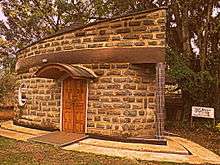
In the later decades of the 19th century, at the time when the early European explorers started advancing into the interior of Kenya. They first arrived in territory occupied by the Lembus People and faced fierce resistance. In the late 19th century, the Lembus fought with the British to protect their lands and more so their forest (Lembus Forest). The Lembus resistance eventually led to a peace treaty being signed between the British and the Lembus in a ceremony at Kerkwony in Eldama Ravine.
The Nandi people were also resisting the British almost the same time with Lembus. Led by Koitalel Arap Samoei, the Nandi resisted the British by waging a hard fought war. Thompson in 1883 was warned to avoid the country of the Nandi, who were known for attacks on strangers and caravans that would attempt to scale the great lands of the Mau.[19]
Matson, in his account of the resistance, shows 'how the irresponsible actions of two British traders, Dick and West, quickly upset the precarious modus vivendi between the Nandi and incoming British'.[20] This would cause more than a decade of conflict led on the Nandi side by Koitalel Arap Samoei, the Nandi Orkoiyot at the time.
Colonial Period
Politics & Identity
Until the mid-20th century, the Kalenjin did not have a common name and were usually referred to as the 'Nandi-speaking tribes' by scholars and colonial administration officials.[21]

Starting in the 1940s, individuals from the various 'Nandi-speaking tribes' who had been drafted to fight in World War II (1939–1945) began using the term Kale or Kore (a term that denoted scarification of a warrior who had killed an enemy in battle) to refer to themselves. At about the same time, a popular local radio broadcaster by the name of John Chemallan would introduce his wartime broadcasts show with the phrase Kalenjok meaning "I tell You" (when said to many people). This would influence a group of fourteen young 'Nandi-speaking' men attending Alliance School and who were trying to find a name for their peer group. They would call it Kalenjin meaning "I tell you" (when said to one person). The word Kalenjin was gaining currency as a term to denote all the 'Nandi-speaking' tribes. This identity would be consolidated with the founding of the Kalenjin Union in Eldoret in 1948 and the publication of a monthly magazine called Kalenjin in the 1950s.[22]
In 1955 when Mzee Tameno, a Maasai and member of the Legislative Assembly (LEGCO) for Rift Valley, tendered his resignation, the Kalenjin presented one candidate to replace him; Daniel Toroitich arap Moi.[23]
By 1960, concerned with the dominance of the Luo and Kikuyu, Arap Moi and Ronald Ngala formed KADU to defend the interests of the countries smaller tribes. They campaigned on a platform of majimboism (devolution) during the 1963 elections but lost to KANU. Shortly after independence in December 1963, Kenyatta convinced Moi to dissolve KADU. This was done in 1964 when KADU dissolved and joined KANU.
Religion
Christianity was introduced and rapidly spread through Kalenjin speaking areas during the colonial period. Traditional Kalenjin religion which was undergoing separate change saw a corresponding decline in this time.[24]
Food
The colonial period saw the introduction of tea cultivation on a large scale in the Kericho and Nandi highlands. These regions have since played a significant role in establishing Kenya as the world’s leading exporter of tea and also in establishing a tea-drinking culture among the Kalenjin. This period also saw the introduction of the mid-day meal as well as the addition of wheat based foods such as bread and less often pancakes and maandazi to the morning meal[25].
Literacy
A significant cultural change of the colonial period was the introduction and adoption of the Latin script for transcribing first the Bible, and later Kalenjin lore and history.[26]
Recent History
Demographics
According to the Kenya's 2009 census, Kalenjin speakers number 4,967,328 individuals, making it the third largest ethnic group in Kenya after the Kikuyu and the Luhya.[2]
Subdivisions
There are several tribal groupings within the Kalenjin: They include the Keiyo, Endorois, Kipsigis, Marakwet, Nandi, Pokot, Terik, Tugen and Sebei.
Culture
Contemporary Kalenjin culture is a product of it's heritage, the suite of cultural adoptions of the British colonial period and modern Kenyan identity from which it borrows and adds to.

Occupation
Agriculture
A significant majority of Kalenjin speakers are primarily subsistence farmers, they cultivate grains such as maize and wheat and to a lesser extent sorghum and millet or practice a pastoralist lifestyle; rearing beef, goats and sheep for meat production. Equally large numbers practice a combination of both farming and livestock (often dairy cattle) rearing[27]. The counties of Uasin Gishu, Trans Nzoia and to a lesser extent Nakuru are often referred to as Kenya's grain-basket counties and are responsible for supplying much of the country's grain requirements.
Pastoralism
In the northern areas such as Pokot and Baringo, pastoralism is the primary occupation and meat products are particularly appreciated for their flavor and are favored in the Rift for the preparation of nyama choma[28].
Urban Life
A significant number of Kalenjin have moved to Kenya's cities where large numbers are employed in the Kenyan Government, the Army, Police Force, the banking and finance industry as well as in business.

Language
The Kalenjin speak Kalenjin languages as mother tongues. The language grouping belongs to the Nilo-Saharan family. The majority of Kalenjin speakers are found in Kenya with smaller populations in Tanzania (e.g., Akie) and Uganda (e.g., Kupsabiny).
Kiswahili and English, both Kenyan national languages are widely spoken as second and third languages by most Kalenjin speakers and as first and second languages by some Kalenjin[29].
Religion
Almost all modern Kalenjin are members of an organised religion with the vast majority being Christian and a few identifying as Muslim.[30]
Elders
The Kalenjin have a council of elders composed of members of the various Kalenjin sub-tribes and known as the Myoot Council of Elders. This council was formed in the Kenyan post-independence period[31][32].
Initiation
The initiation process is a key component of Kalenjin identity[33]. Among males, the circumcision process is seen as signifying one's transition from boyhood to manhood and is taken very seriously[34]. On the whole the process still occurs during a boys pre-teen/early teenage years though significant differences are emerging in practice. Much esotericism is still attended to in the traditional practice of initiation and there was great uproar amongst Kalenjin elders in 2013 when aspects of the tradition were openly inquired into at the International Court[35]. Conversely a number of urban Kalenjin have the circumcision process carried out in hospital as a standard surgical procedure and various models of the learning process have emerged to complement the modern practice. For both orthodox and urban traditions however the use of ibinwek is in decline and the date has been moved from the traditional September/October festive season to December to coincide with the Kenyan school calendar.
The female circumcision process is perceived negatively in the modern world (see: FGM) and various campaigns are being carried out with the intention of eradicating the practice among the Kalenjin[36]. A notable anti-FGM crusader is Hon. Linah Jebii Kilimo.
Folklore
Like all oral societies, the Kalenjin developed a rich collection of folklore. Folk narratives were told to pass on a message and a number featured the Chemosit (Nandi Bear), known in Marakwet as Chebokeri, the dreaded monster that devoured the brains of disobedient children.[37]
The Fall of the Long’ole Clan is a popular tale based on the true-story of the Louwalan clan of the Pokot. The story is told to warn against pride. In the story, the Long’ole warriors believing they were the mightiest in the land goaded their distant rivals the Maasai into battle. The Maasai, though at first reluctant eventually attacked wiping out the Long’ole clan.[38]
Modern literature
A number of writers have documented Kalenjin history and culture, notably B. E. Kipkorir,[39][40] Paul Kipchumba, and Ciarunji Chesaina.[41]
Cuisine
Ugali, known in Kalenjin as kimnyet, served with cooked green vegetables such as kale, and milk form the staples of the Kalenjin diet. Less often ugali, rice or chapati, is served with roast meat, usually beef or goat, and occasionally chicken. The traditional ugali, made of millet and sorghum, and known as psong'iot has seen a resurgence in popularity in tandem with global trends towards healthier eating. The traditional drink mursik, and honey, both considered delicacies for a long time remain quite popular.
Tea-drinking is a significant part of Kalenjin culture. Tea is usually taken in the morning with breakfast, at 10:00AM and at four in the afternoon. Whenever a guest drops in, it is customary to offer a cup of tea and depending on the nature of visit and visitor, an accompanying snack.
In addition to bread, people routinely buy foodstuffs such as sugar, tea leaves, cooking fat, sodas (most often Orange Fanta and Coca-Cola), and other items that they do not produce themselves.[42]
Sport
Athletic prowess The Kalenjin have been called by some "the running tribe." Since the mid-1960s, Kenyan men have earned the largest share of major honours in international athletics (track and field) at distances from 800 meters to the marathon; the vast majority of these Kenyan running stars have been Kalenjin.[43] From 1980 on, about 40% of the top honours available to men in international athletics at these distances (Olympic medals, World Championships medals, and World Cross Country Championships honours) have been earned by Kalenjin.
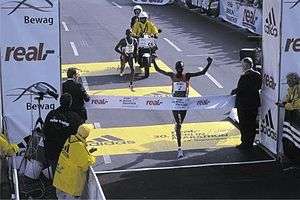
In 2008, Pamela Jelimo became the first Kenyan woman to win a gold medal at the Olympics; she also became the first Kenyan to win the Golden League jackpot in the same year.[44] Since then, Kenyan women have become a major presence in international athletics at the distances; most of these women are Kalenjin.[43] Amby Burfoot of Runner's World stated that the odds of Kenya achieving the success they did at the 1988 Olympics were below 1:160 billion. Kenya had an even more successful Olympics in 2008.
A number of theories explaining the unusual athletic prowess among people from the tribe have been proposed. These include many explanations that apply equally well to other Kenyans or people living elsewhere who are not disproportionately successful athletes, such as that they run to school every day, that they live at relatively high altitude, and that the prize money from races is large compared to typical yearly earnings. One theory is that the Kalenjin has relatively thin legs and therefore does not have to lift so much leg weight when running long distances.[45]
See also
Notes
- ↑ [Ethnologue]
- 1 2 Census: Here are the numbers. Retrieved 25 October 2012.
- 1 2 Ehret, Christopher. An African Classical Age: Eastern & Southern Africa in World History 1000 B.C. to A.D.400. University of Virginia, 1998, p.7
- ↑ Clark, J., & Brandt, St, From Hunters to Farmers: The Causes and Consequences of Food Production in Africa. University of California Press, 1984, p.234
- ↑ Ehret, Christopher. An African Classical Age: Eastern & Southern Africa in World History 1000 B.C. to A.D.400. University of Virginia, 1998, p.161-164
- ↑ Nandi and Other Kalenjin Peoples – History and Cultural Relations, Countries and Their Cultures. Everyculture.com forum. Accessed 19 August 2014.
- ↑ Spear, T. and Waller, R. Being Maasai: Ethnicity & Identity in East Africa. James Currey Publishers, 1993, p. 42 (online)
- ↑ Kyule, David M., 1989, Economy and subsistence of iron age Sirikwa Culture at Hyrax Hill, Nakuru: a zooarcheaological approach p.211
- ↑ Spear, T. and Waller, R. Being Maasai: Ethnicity & Identity in East Africa. James Currey Publishers, 1993, p. 42 (online)
- ↑ Pavitt, N. Kenya: The First Explorers,Aurum Press, 1989, p. 107
- 1 2 Spear, T. and Waller, R. Being Maasai: Ethnicity & Identity in East Africa. James Currey Publishers, 1993, p. 44-46 (online)
- ↑ Hollis A.C, The Nandi – Their Language and Folklore. The Clarendon Press, Oxford, 1909, p. xvii
- ↑ Katsuyoshi, F., & Markakis, J., Ethnicity & Conflict in the Horn of Africa, p.67-68[online]
- ↑ Trillo, R., The Rough Guide to Kenya, Rough Guides p.636
- ↑ Spear, T. and Waller, R. Being Maasai: Ethnicity & Identity in East Africa. James Currey Publishers, 1993, p. 47 (online)
- ↑ Nandi and Other Kalenjin Peoples – History and Cultural Relations, Countries and Their Cultures. Everyculture.com forum. Accessed 19 August 2014
- ↑ Chesaina, C. Oral Literature of the Kalenjin. Heinmann Kenya Ltd, 1991, p. 2
- ↑ Ehret, Christopher. An African Classical Age: Eastern & Southern Africa in World History 1000 B.C. to A.D.400. University of Virginia, 1998, p.178
- ↑ Pavitt, N. Kenya: The First Explorers,Aurum Press, 1989, p. 121
- ↑ Nandi Resistance to British Rule 1890–1906. By A. T. Matson. Nairobi: East African Publishing House, 1972. Pp. vii+391
- ↑ cf. Evans-Pritchard 1965.
- ↑ Countries & their Cultures; Kalenjin online
- ↑ Chesang, W. The Standard Moi and the Kalenjin: Just who owes who what? August 12, 2016
- ↑ Kalenjin Tribe, People, Language, Culture and Traditions - Kalenjin Religion & Expressive Culture[online]
- ↑ Kalenjin Tribe, People, Language, Culture and Traditions - Food[online]
- ↑ Countries & their Cultures, Kalenjin online
- ↑ Countries and their Cultures[online]
- ↑ DP Ruto shocks Baringo farmers after buying 1,000 goats for Sh12 million cash[online]
- ↑ Countries and their Cultures[online]
- ↑ Kalenjin Tribe, People, Language, Culture and Traditions - Kalenjin Religion & Expressive Culture[online]
- ↑ Respect title deeds, elders tell State[online]
- ↑ Show of unity: Kalenjin, Gema elders pay Sh300,000 for sick Luo colleague[online]
- ↑ One of The Nandis’ Oldest Ritual of All Time[online]
- ↑ Understanding Kalenjin Initiation Rites[online]
- ↑ Is the Kalenjin’s age-old tradition under trial at the International Criminal Court?[online]
- ↑ Over 70 girls in Nandi County graduate from special training [online]
- ↑ Kipchumba, P., Oral Literature of the Marakwet of Kenya, Nairobi: Kipchumba Foundation ISBN 978-1-9731-6006-9 ISBN 1-9731-6006-4
- ↑ Chesaina, C. Oral Literature of the Kalenjin. Heinmann Kenya Ltd, 1991, p. 39
- ↑ The writer I knew: Remembering Benjamin Kipkorir, Nation online
- ↑ Benjamin Kipkorir, the reluctant academic, Standard online
- ↑ Cianrunji Chesaina, online
- ↑ Kalenjin Tribe, People, Language, Culture and Traditions - Food[online]
- 1 2 Why Kenyans Make Such Great Runners: A Story of Genes and Cultures, Atlantic online
- ↑ Million Dollar Legs,The Guardian online
- ↑ Running Circles around Us: East African Olympians’ Advantage May Be More Than Physical, Scientific American online
Bibliography
- Evans-Pritchard, E.E. (1965) 'The political structure of the Nandi-speaking peoples of Kenya', in The position of women in primitive societies and other essays in social anthropology, pp. 59–75.
- Entine, Jon. (2000) 'The Kenya Connection', in TABOO: Why Black Athletes Dominate Sports And Why We're Afraid to Talk About It. https://web.archive.org/web/20081209004844/http://www.jonentine.com/reviews/quokka_03.htm
- Kipchumba Foundation (2017) Aspects of Indigenous Religion among the Marakwet of Kenya, Nairobi: Kipchumba Foundation, ISBN 978-1-9732-0939-3 ISBN 1-9732-0939-X
- Omosule, Monone (1989) 'Kalenjin: the emergence of a corporate name for the 'Nandi-speaking tribes' of East Africa', Genève-Afrique, 27, 1, pp. 73–88.
- Sutton, J.E.G. (1978) 'The Kalenjin', in Ogot, B.A. (ed.) Kenya before 1900, pp. 21–52.
- Larsen, Henrik B. (2002) 'Why Are Kenyan Runners Superior?'
- Tanser, Toby (2008) More Fire. How to Run the Kenyan Way.
- Warner, Gregory (2013) 'How One Kenyan Tribe Produces The World's Best Runners'
